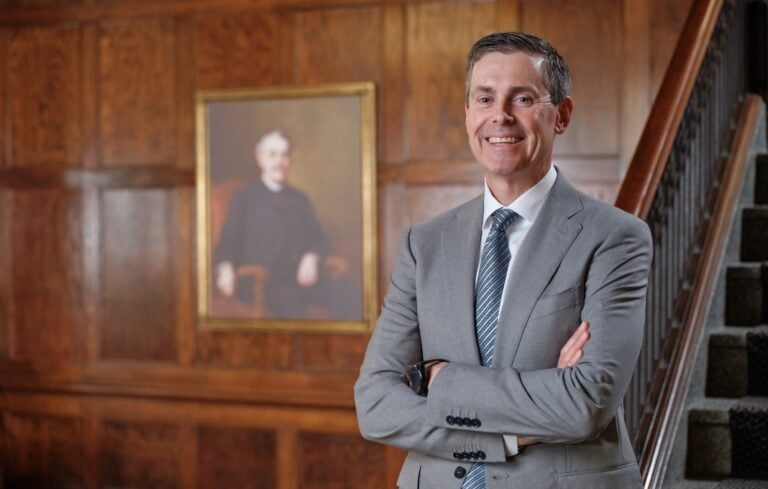
Thirty-eight years ago, the last slide rule was manufactured; yet just seven years earlier, on July 20, 1969—the day man first stepped onto the lunar surface—Astronauts Armstrong, Aldrin and Collins wouldn’t leave home without one.
One president’s vision, and one chief executive’s leadership and execution, brought together an entire nation and an organization (NASA) to overcome gravity, differing political opinions, and antiquated technology to transform the most barren of landscapes into one of the greatest achievements in modern history. The methods he used are still applicable today.
Back in the sixties, we chose goals such as going to the moon not because they were easy, but because they were hard. Because that goal served to harness the best of our energies and skill. Because that challenge was one we were willing to accept, one we were unwilling to postpone, and one which we intended to win. This vision by President John F. Kennedy inspired a nation with a belief that a moon landing was possible, but who could execute on such a lofty objective?
James E. Webb was hired as chief administrator at fledgeling NASA in 1961 to turn Kennedy’s vision into a new historical era. Webb knew that with his extraordinary pool of talent and egos ranging from janitors to astronauts, it would be no small challenge if he was going to nurture and inspire his employees’ intrinsic motivation, cooperation and curiosity for the next eight years, regardless of how exciting the outcome might be.
To motivate his team, Webb focused on collaboration and cooperation—two personal attributes that nurture and bring forth man’s inquisitive nature to seek out and learn about things they don’t know, while improving upon the things they do. To achieve this, a leader must be the first to set aside his or her ego, and then learn to rely upon his fellow man.
These two principles defined Webb’s leadership during the initial Apollo projects. They gave management tools for improving the rate of innovation and quality, which then allowed the agency to fulfill its single customer’s objective faster.
There were no guarantees Kennedy’s vision or Webb’s strategies would work. They both took risks by believing that man’s desire to do great things would overcome the obstacles gravity could throw at them, and by believing their respective team’s execution would turn their vision into reality, despite heavy dissension. Even Astronaut Armstrong only gave Apollo 11 a 50/50 chance of succeeding.
One large challenge that Webb, as leader, had to overcome was getting everyone to agree on how best to get a man into space, onto the moon, then safely back to earth. If collaboration and cooperation could not overcome what was surely a rigorous opposition, the lunar landing would likely not be achieved.
Employees such as former German born rocket scientist Wernher von Braun strongly argued for one method, while others, such as Iowa born engineer John Houbolt, vociferously argued for another. Wildly differing opinions were discussed within the organization before consent emerged about which method might work best.
NASA’s innovations were accomplished under the watchful eyes of leaders well trained in engaging man’s intrinsic curiosity for improvement. These leaders engaged employees to put ideas into actionable experiments, and ultimately, innovations. Whether leaders are internal employees or outside consultants, it takes special skills to inspire collaboration and cooperation, rather than fear and intimidation.
According to management guru Dr. W. Edwards Deming, fear, even though the most common motivation technique (but extremely ineffective) must be driven completely out of the organization before either can be achieved. Teams tend to do their best work in environments where fear is eliminated, curiosity promoted, and collaboration and cooperation nurtured along by leaders who have the organization’s talent, and best interests at heart.
Fostering collaboration and cooperation can drive tangible benefits at any company, but don’t run out and think you can change your company’s environment overnight. Change has to be gradual and progressive. Here are three ideas that can help:
1. Have a constancy of purpose. Hired in 1961, Webb was not a scientist, physicist, or mathematician, yet he led with a purpose. Landing a man on the moon would serve as his catalyst for strengthening America’s space program, universities, and aerospace business. This improvement effort became Webb’s constancy of purpose. As Dr. Deming said, “when there is no direction, then there is disease in the organization. Lack of organizational direction is not like a cold, or flu, it is not benign. Lack of consistent organizational direction is deadly, it will send a company down the tubes.”
2. Test theories against desired outcomes. Transformational shifts in thinking occur by listening and learning from others who disagree. Webb encouraged teams to whittle down ideas for improvement through theory, testing, and application using scientific and mathematical experiments. Teams learned from these experiments, improved the product, and gained new knowledge from each event and one another. Testing theories against desired outcomes engaged employees in the idea of improvement by using the ideas, input, and knowledge of conditions they were routinely encountering.
3. Incorporate double-loop learning. Our organizational communication capacity seems always to be declining. To change this, Craig Weber, author of the book Conversational Capacity, proposes that double-loop learning helps expand our ability to speak openly and freely with one another about difficult subjects. It teaches us how to balance our candor with our curiosity by advocating and illustrating our ideas, then testing them, and lastly, inquiring from our other team members about what they have may have experienced given similar conditions. As Weber says, “The more complex and unfamiliar the challenge we’re facing, the more important it becomes for chief executives to test and adjust the underlying ladders of inference, beliefs and filters they’re using to tackle it.”
Forty-five years ago, Webb overcame what might appear to some to be insurmountable odds by fostering collaboration and cooperation among his team. With the same proactive approach, there is nothing you can’t achieve in your own firm.



0

1:00 - 5:00 pm
Over 70% of Executives Surveyed Agree: Many Strategic Planning Efforts Lack Systematic Approach Tips for Enhancing Your Strategic Planning Process
Executives expressed frustration with their current strategic planning process. Issues include:
Steve Rutan and Denise Harrison have put together an afternoon workshop that will provide the tools you need to address these concerns. They have worked with hundreds of executives to develop a systematic approach that will enable your team to make better decisions during strategic planning. Steve and Denise will walk you through exercises for prioritizing your lists and steps that will reset and reinvigorate your process. This will be a hands-on workshop that will enable you to think about your business as you use the tools that are being presented. If you are ready for a Strategic Planning tune-up, select this workshop in your registration form. The additional fee of $695 will be added to your total.

2:00 - 5:00 pm
Female leaders face the same issues all leaders do, but they often face additional challenges too. In this peer session, we will facilitate a discussion of best practices and how to overcome common barriers to help women leaders be more effective within and outside their organizations.
Limited space available.

10:30 - 5:00 pm
General’s Retreat at Hermitage Golf Course
Sponsored by UBS
General’s Retreat, built in 1986 with architect Gary Roger Baird, has been voted the “Best Golf Course in Nashville” and is a “must play” when visiting the Nashville, Tennessee area. With the beautiful setting along the Cumberland River, golfers of all capabilities will thoroughly enjoy the golf, scenery and hospitality.
The golf outing fee includes transportation to and from the hotel, greens/cart fees, use of practice facilities, and boxed lunch. The bus will leave the hotel at 10:30 am for a noon shotgun start and return to the hotel after the cocktail reception following the completion of the round.